Instagram vs TikTok: A Comparative Breakdown of Features, Strengths, and Weaknesses
Check out a detailed comparison of Instagram vs TikTok to see how each stacks up in terms of features and what its main marketing benefits are.


If you’re set on making a splash on social media through short-form video, you’re facing a choice: Instagram marketing or TikTok marketing.
Both channels have massive potential and an ever-expanding user base, so the key is to figure out which one is the right match for your brand.
A full comparison of Instagram vs TikTok
- Discover platform focus and main differentiators between the two social networks.
- Dig into demographics and performance data (such as engagement, impressions, shares)
- Understand which tools and capabilities each platform offers.
TikTok vs Instagram: platform focus and main differentiators
TikTok and Instagram might seem alarmingly similar at a glance – like two sides of the same coin — especially with them sharing so many features related to short-form video.
But when you start exploring the differences between TikTok and Instagram, you'll notice unique features and characteristics that give each platform its own personality and make them stand out from one another.
On the one hand, you have Instagram, a heavily visual platform that prioritizes curated, polished, aesthetic content, whether that’s carousels, Stories or Reels.
So then what type of content is most popular on TikTok? Well, TikTok is a social media space that completely embraces authentic, spontaneous, low-production content, so that’s what performs best on this platform.
Essentially, one platform leans into the art of storytelling, the other is all about the heat of the moment.
How effective your social media marketing is depends on understanding these differences, by using Instagram for well-planned content and TikTok for the spontaneous.
To see many other ways in which TikTok and Instagram are different, take a look below:
Demographics and performance data for TikTok vs Instagram
Since the two platforms have rather distinct styles, it’s no surprise that they also attract different crowds.
The Instagram users vs TikTok users dynamic plays a huge role in how content is received. That’s why the same message will never land in the same way on both platforms, and that is why social media strategists and social media managers have to be careful how to plan and deliver their messages across these platforms.
Instagram tends to attract a more mature audience and it’s generally considered a Millennial hotspot. According to the latest demographics data from Statista, 28.3% of U.S. users fall into the 25-34 range. Gen Z is not far behind, making up 26.5% of the user base as of January 2025.
TikTok, on the other hand, is basically every Gen Zer’s first choice when it comes to social media. While other age groups are slowly starting to see the appeal of this platform, its core audience is still made up of users between 18 and 24 who enjoy highly dynamic, experimental content.
The target audience segmentation is a significant difference between TikTok and Instagram, but it’s not by far the only one.
Engagement comparison
Before we look at the social media analytics data, take a second and ask yourself: whenever you hear that something’s gone viral, what platform do you think of first? Is it easier to go viral on TikTok or Instagram?
Data in our latest social media benchmarks report indicates that more often than not, the answer is TikTok.
And we’re not just talking about sudden spikes of engagement and visibility correlated with virality, but a consistent high engagement rate that speaks volumes about how active users are on this platform and how much they like to interact with the content that’s shared. This applies across TikTok content types.
In 2025, the TikTok engagement rate sits at a whopping 2.50%.
Switching over to Instagram analytics, the engagement rate on this platform is noticeably lower, and it’s been steadily declining year after year. But this doesn’t necessarily mean a lack of activity or interest
. People are still sharing tons of content, which suggests that Instagram might be focusing more on maximizing reach instead of driving engagement.
The Instagram engagement rate as of 2025 is 0.50%.
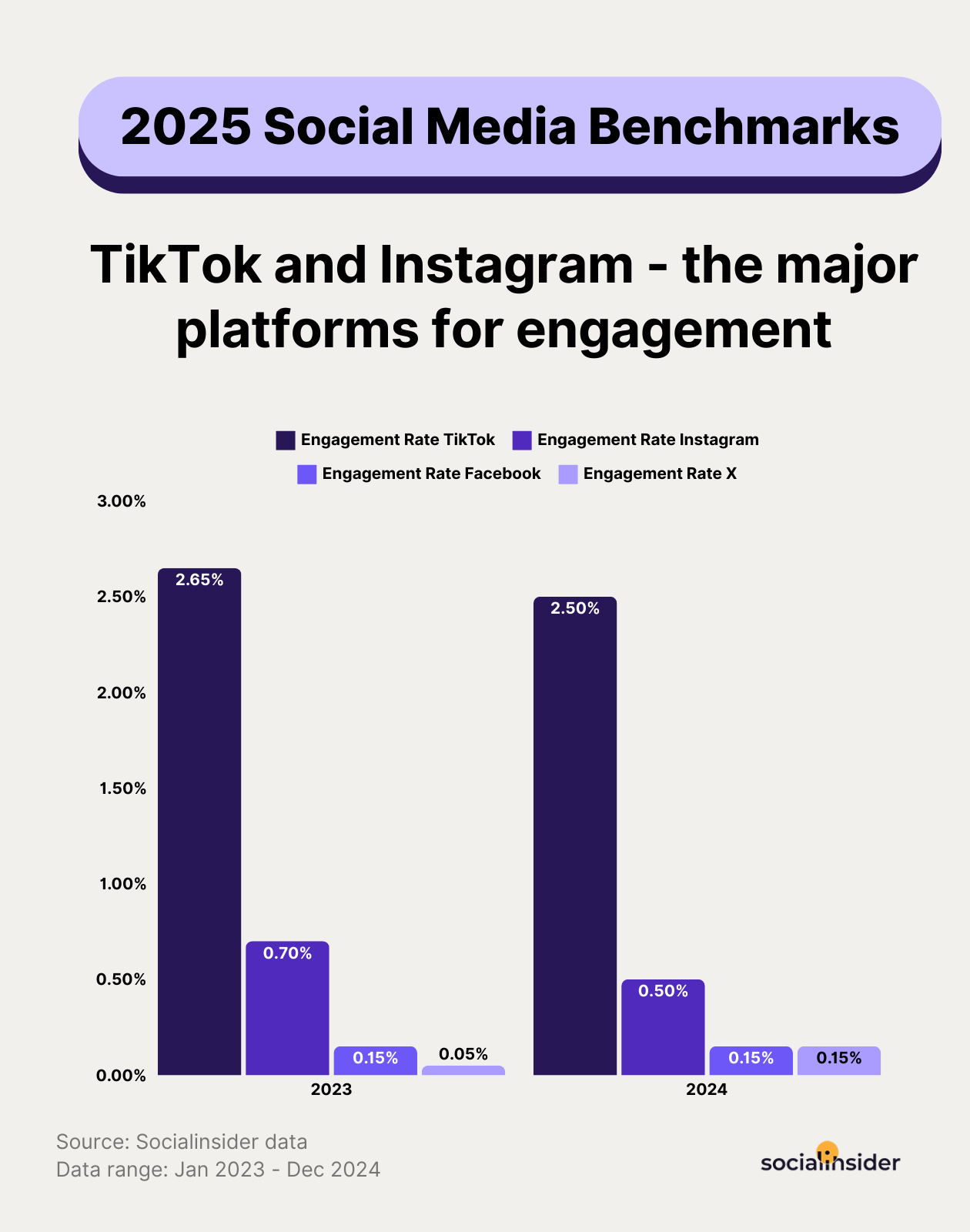
Comments & shares comparison
TikTok consistently outperforms Instagram in engagement, especially when it comes to comments and shares.
When we compare TikTok vs Instagram social media analytics we see that TikTok content gets more comments on average than any other platform, which speaks volumes about its content’s power to spark conversations and turn people from casual scrollers to invested followers.
Same goes for shares. TikTok videos tend to be more shareable, which makes them spread far and wide and gain visibility faster than on any other social media platform.
As you can see from the charts, this trend is not new. In fact, TikTok has been topping the engagement charts for the past two years, and it’s not showing any signs of slowing down.
Impressions comparison
TikTok is not only leading in terms of engagement, but also visibility. The average impressions TikTok posts get far surpass Instagram posts.
In 2025, TikTok averages about 6268 impressions per post, while Instagram only goes up to 2635. That’s because this platform’s algorithm favors discoverability and puts engaging social media content in front of the right viewers, whether they follow you or not.
So when you post to TikTok and Instagram, know that TikTok's algorithm actually makes it easier to reach new audiences and increase your content's exposure.

So what does this all mean?
While it may seem like TikTok takes all the prizes, leaving Instagram with little space to shine and evolve, the reality is more nuanced.
When we consider the popularity of TikTok vs Instagram, along with demographics, engagement, and impressions data, here’s what we suggest:
- If you are looking for a high-energy space to share brand content, a platform with massive viral potential and high engagement, TikTok might be your best bet.
- If you want to create a more polished brand presence that appeals to a more diverse, non-Gen Z exclusive audience, in this case, Instagram remains a strong contender.
Social media analytics comparison
Instagram and TikTok each have their own tools, insights, and quirks.
Whether you’re on a mission to improve your content strategy or simply curious about what’s working and what’s not), understanding how each platform measures success – from engagement rates to audience behavior – is key.
Here’s a detailed breakdown:
Key Metrics
Account Overview:
- Instagram: Followers, profile visits, views
- TikTok: Followers, video views, profile views
Engagement Metrics:
- Instagram: Likes, comments, saves, shares, DMs
- TikTok: Likes, comments, shares, favorites
Performance Indicators:
- Instagram: Engagement rate by followers (typically ~0.50% in 2025)
- TikTok: Engagement rate by views (typically ~3.30% in 2024)
Video Metrics:
- Instagram: Views, average watch time, video length
- TikTok: Views, average watch time, total play time, video length
Reach Metrics:
- Instagram: Reach, impressions, audience growth
- TikTok: Reach, video views
Audience Demographics:
- Both Platforms: Age, gender, location, active hours
Content Performance:
- Instagram: Best-performing posts by engagement
- TikTok: Best-performing videos by engagement and watch time
Analytics Dashboards
In-app Analytics:
- Instagram: Instagram Insights (limited historical data)
- TikTok: TikTok Analytics (more comprehensive)
Desktop Analytics:
- Instagram: Creator Studio
- TikTok: TikTok Creative Center
Historical Data:
- Instagram: Typically 30-90 days depending on the metric
- TikTok: Up to 60 days for most metrics
Social media analytics tools such as Socialinsider
- Instagram: in-depth Instagram analytics, content performance analysis and competitive benchmarking, history posts and followers data.
- TikTok: comprehensive TikTok analytics, content pillars performance, history posts and followers.
Metric Granularity:
- Instagram: Daily, weekly, monthly views
- TikTok: Hourly, daily, weekly, monthly views
Export Options:
- Instagram: Limited export options
- TikTok: More robust export capabilities
Real-time Data:
- Instagram: Limited real-time insights
- TikTok: Better real-time performance tracking
Content-Specific Analytics
Post Analytics:
- Instagram: Separate metrics for feed posts, Reels, Stories
- TikTok: Focus on video analytics with detailed performance
Key Content Metrics:
- Instagram: Engagement by post type, best time to post
- TikTok: Video performance, sound usage, trending topics
Content Lifespan Tracking:
- Instagram: Focuses on first 48 hours of performance
- TikTok: Tracks longer content lifespan with resurface data
Hashtag Analytics:
- Instagram: Basic hashtag performance
- TikTok: Detailed hashtag trends and performance
Sound/Music Analytics:
- Instagram: Limited sound performance data
- TikTok: Comprehensive sound usage and trend analytics
Audience Insights
Follower Growth:
- Instagram: Daily/weekly follower changes
- TikTok: Detailed follower acquisition sources
Audience Behavior:
- Instagram: Content preferences, active times
- TikTok: Content preferences, watch patterns, interaction habits
Custom Segments:
- Instagram: Limited audience segmentation
- TikTok: Better audience interest categorization
Competitor Analysis:
- Instagram: Not built-in (requires third-party tools such as Socialinsider)
- TikTok: Not built-in (requires third-party tools such as Socialinsider)
Audience Loyalty:
- Instagram: Returning followers metrics
- TikTok: Follower vs. non-follower view breakdown
Content creation tools and capabilities
Both platforms include massively powerful content creation tools and features, but the differences between Instagram and TikTok lie in how these tools can be used on each platform.
Video creation: length, editing tools & effects
TikTok initially set a 60-second limit for all its videos, but has now grown to support videos of up to 10 minutes. Its built-in editor is quite powerful and intuitive, allowing you to trim clips, add transitions and special effects, use trending songs, all without the need to use a third-party app.
One of the benefits of using TikTok is that this platform boasts a massive library of effects and templates. One of its standout features is AutoCut, an AI-powered tool that auto-edits your video based on the song or template you choose (similar to Instagram's auto-editing feature for Reels).
In response to TikTok’s influence, but also largely due to the rising popularity of Reels, which prompted the demand for longer content, Instagram now allows videos up to 3 minutes long.
Instagram’s editing tools have improved much over the past few years, and include everything from quick trims to special effects, popular sounds, auto-captions and more.
However, they are not as intuitive as TikTok, which sometimes forces creators to look to external editing tools like CapCut or InShot before uploading.
Photo capabilities and filters
Despite introducing photo-based slideshows (aka TikTok carousels) and templates, TikTok is still a video-first platform, which means its photo-editing capabilities are pretty basic (at least, compared to Instagram).
With that in mind, why might you use TikTok over Instagram? Well, if you're more focused on creating engaging, short-form video content rather than polished photos, TikTok is the right choice for you.
By comparison, Instagram was built for sharing photos, which means it comes equipped with many flexible photo-editing options, from customizable filters to advanced tools for color correction, contrast – in other words, it gives much more creative control over your images.
Music and sound integration
TikTok thrives on music and trending sounds – and these play a massive role in making posts achieve massive visibility and even go viral.
You can browse its vast sound library to find thousands of trending songs, viral sounds and original (user-made) audio clips. Having access to this ever-growing library of trending songs is one of the greatest advantages of TikTok.
Some would argue that Instagram is on par with TikTok when it comes to music and sound integration.
However, one of the main weaknesses of Instagram lies in its sound library, which, although huge, is subject to more copyright restrictions than TikTok.
On the plus side, users can tap into the same music library to add songs to their Reels, Stories and standard feed posts.
AR features & effects
TikTok includes a wide variety of interactive AR features like face filters, custom background and green screen effects.
To allow for full creative freedom, the platform also allows users to create their own filters in the TikTok Effect House (soon to be powered by an AI assistant!).
So why use TikTok over Instagram? If you love experimenting with creative tools, TikTok’s wide range of customization options makes it an obvious choice.
Instagram is not lagging far behind, offering many AR features like 3D effects and face filters for creators to spice up their content. However, by comparison, TikTok’s library is growing faster by keeping up with the trends.
Creator Studio vs TikTok Creative Center
TikTok’s Creative Center is packed with useful data on real-time trends, ad inspiration and insights and everything else brands and influencers need to know about what’s buzzing on the platform and what’s happening in their niche.
By comparison, Instagram’s Creator Studio is a go-to hub for analytics, monetization tools and post scheduling features. It’s great for managing content and getting performance reports, less useful for keeping up with trends.
Algorithm and content discovery comparison
While TikTok and Instagram do share some similarities, it's important to compare the TikTok algorithm vs the Instagram algorithm and see where they diverge so that you can build a specific strategy that works for each platform.
How each algorithm works
TikTok’s algorithm is highly dependent on what you interact with. It tracks your engagement – likes, comments, shares, watch time – and uses that information to create relevant content recommendations.
When considering what are the pros and cons of TikTok, one major upside is that the algorithm doesn’t favor big creators over small ones – each has their chance to show up in your feed as long as they’re relevant.
Instagram, on the other hand, leans more into established accounts and people you already interact with on a regular basis. This is great for building stronger connections with your audience, but it doesn’t do you as many favors in terms of discoverability.
For You Page vs. Explore Page
Since the For You Page (FYP) is a direct result of how the TikTok algorithm works, you can expect this space to be filled with many videos that match your interests – which includes new and established creators alike.
So if you're asking what is TikTok good for, one clear answer is content discovery.
Instagram’s Explore Page works similar to TikTok’s FYP, in that it is a great place to find fresh content.
However, it’s much more focused on popular posts and accounts you’ve already interacted with (or similar accounts from the same niche) and it doesn’t as much to push new creators compared to TikTok.
Virality
Whenever someone talks about going viral on social media, TikTok is the first thing on their mind. This platform is designed to thrive on trends, snappy clips and shareable content. So why is TikTok better than Instagram? Its virality potential is unmatched.
Due to its tendency to rely on existing audiences and connections, going viral on Instagram is slightly trickier.
Your best chance to get the algorithm to notice your content and eventually go viral is to have a strong push from your followers (aka high engagement, plenty of views and/or shares).
Content lifespan and shelf life
What do people use TikTok for? Many enjoy it not just for trending content but also for its ability to keep older posts in circulation. That’s right – despite the platform’s preference for fresh content, on TikTok, your content may stay relevant and gain traction for a while after you post it.
Long after the initial surge in engagement or TikTok views, older videos may resurface after a while if they get a bit more attention, which extends their shelf-life.
On Instagram, your content’s fate is usually decided in the first 48 hours. Most of the engagement and visibility a post can gain on Instagram happens within this timeframe.
Although it can still generate likes or views, its chances of staying relevant decrease significantly after the first couple of days. So that might be why you prefer TikTok over Instagram.
Business features comparison
Using TikTok and Instagram as a business requires a strategic approach, where the key is to know what tools to use in order to connect with relevant creators, sell products, and measure your progress.
Brand partnership opportunities
If you're wondering what are the pros of TikTok for businesses, one major advantage is the variety of partnership opportunities. TikTok makes it easy to find influencers to partner with through its Creator Marketplace.
Using filters based on audience demographics or engagement levels, you have a good chance to find a great fit for your brand. Outside of that, there’s also the option to create branded hashtag challenges where other brands or creators can join – which can turn into collaboration opportunities in a more organic way. On
Instagram, paid branded partnerships are very common and can be easily marked with the branded content tool, while collab posts are a great help for influencer marketing, helping brands tap into new audiences without having to be too salesy.
So is it easier to grow on TikTok or Instagram? It depends. TikTok, with its highly engaging algorithm and viral potential, can give brands a quicker growth spurt, while Instagram requires a more strategic approach but more access to quality partnership opportunities.
In-app shopping features
How is TIkTok used for brands to practice social selling you might ask. Well, TikTok keeps social commerce booming with TikTok Shopping. This in-app shopping feature makes it easy for brands to showcase their products, create shoppable posts and even sponsor live shopping events.
When comparing Instagram Live vs TikTok Live, TikTok’s live shopping feature definitely stands out for its interactive and spontaneous vibe.
Instagram is also going strong in the shopping departments. Their Instagram Shops feature allows brands to create a full-functioning storefront – with product tags and checkout options – which people can visit and interact with without leaving the app.
Advertising
On TikTok, you can experiment with a few ad formats, such as TopView ads (which offer prime real estate on the For You Page), in-feed ads and Spark ads (a way to boost existing content), and monitor their performance through the TikTok Ads Manager.
Fueled by the Meta engine and its powerful targeting tools, Instagram’s ad system is expected to be more precise. You can create ads that pop up just about anywhere, from Stories, to Reels, and carousels, and track how well they’re doing via Meta Ads Manager.
ROI
Why do people use TikTok for massive ROI? Well, TikTok helps brands who aim for massive reach and big virality potential succeed.
Even smaller brands have a fair shot at success and can hope to get a good return on their investment because the algorithm favors engaging content, no matter where it comes from.
Instagram also offers good ROI, if your goal is based around conversion, lead generation and brand positioning. In other words, while it might take longer to see a strong ROI compared to TikTok, the payoff can be worth it.
Community and social dynamics comparison
Both Instagram and TikTok have a reputation for building a sense of community, but they do so in slightly different ways.
Interactive features
Both platforms are good at creating a community-driven experience where users feel like they’re actively shaping the content they see.
From live streams to interactive stickers in Stories (be sure to consistently check your Stories analytics to measure meaningful interactions), there are many ways in which you can make people interact with your content in a way that’s convenient and meaningful to them.
Duets/Remixes vs. Instagram Collabs
Stitches and Duets are a crucial part of TikTok’s culture, and an easy way to create user-generated content. Through these features, users can build on existing content, either by collaborating or reacting. This is part of what makes TikTok unique.
Instagram’s Collabs and Remixes serve a similar purpose but aren’t so engrained in the platform’s culture. With collabs, two accounts essentially share ownership of the same post, while Remixes are closer to TikTok’s Duets.
Culture and content trends
If someone were to ask how is TikTok different from other social media platforms, I’d say it's a space where experimentation and humor are essential, where brands can afford to be more human and spontaneous. TikTok is all about trend-driven, casual, non-polished, authentic content.
Instagram, on the other hand, favors more curated, aesthetic content and places a larger emphasis on storytelling. Trends are a big part of this platform’s culture as well, though they don’t spread as quickly as they do on TikTok.
So why use Instagram over TikTok? Well, if you're into creating a more polished, cohesive vibe, Instagram might be the right space for you.
Privacy, safety and content moderation comparison
Content guidelines and restrictions
Both TikTok and Instagram have established strict guidelines around sensitive content and misinformation, although Instagram is more often criticized for abusing its shadowbanning policies.
When looking at TikTok compared to other social media platforms, I’d say its approach to content moderation is more forgiving in terms of content reach compared to Instagram.
Platform-specific growth strategies
To get the most out of your marketing efforts, it would be best to follow the best practices for each platform.
Strategies for effective Instagram marketing
How often should you post: According to our latest social media benchmarks report, you should share about 5 posts a week for best results.
- Best content mix: Our Instagram benchmarks show that the best content mix for Instagram is 10 images per month (50% of all content shared), 4 carousels per month (20%) 6 Reels per month (30%).
- Ideal Reels length and format: In its current state, the algorithm favors shorter Reels, between 15 and 30 seconds. However, if you want to show something more complex, you can go up to 30-90 seconds. Anything over 90 seconds may hurt distribution. In terms of format, always aim for 9:16.
- How to boost your Reels with sound: Using songs marked as “Trending” from Instagram’s music library can give you a huge visibility boost.
- How to find the best sounds for Reels: To find trending sounds for Instagram, you can either explore the Reels tab and look for songs with an upward arrow next to them (or go straight to the Trending Reels section). Alternatively, you can save songs from Instagram creators who share sound upgrades.
- How to get more traffic via Instagram: On Instagram, organic/paid engagement, SEO and well-placed CTAs (in bio and posts) are bound to generate the highest amount of traffic. Collabs can give you extra exposure which may lead to more traffic in time.
Strategies for effective TikTok marketing
- The 3-second rule: TikTok moves fast, so you cannot waste any second getting your viewers’ attention. To stop them from scrolling, open with a statement hook (“This will change the way you look at…”), or with a question (“Did you know this crazy fact about…?”) and include bold visuals from the start.
- How to spot trending sounds: Similarly to Instagram, popular audio can be found by scrolling on the For You Page and saving any songs that come up more than a couple of times. If you’re lucky, you’ll catch trending sounds before they become a platform-wide sensation! You can also find some popular sounds by browsing through the TikTok Creative Center under the Trends tab.
- Original sounds for discoverability: To create an original, viral-worth sound, you should keep it short and loopable, and encourage people to stitch or duet with it to give some exposure.
- Loop-able content creation: On TikTok, people love to watch the same content multiple times. To use this in your favor, try circular storytelling (aka ending your video in a way that leads right back to the start) or use transitions to create a natural, barely detectable loop.
- Speedy storytelling: Stories still matter on TikTok, you just have to find a way to get to the point fast! Start with a strong hook, then build up curiosity or tension with an intriguing arc, and deliver a satisfying payoff at the end.
- Prioritize visual continuity: With so much content flooding TikTok daily, you need to make it so yours stands out. To make it easier for people to spot (and remember) your content, use similar colors, fonts, or filters across all your posts.
- Keep up the momentum: The more you post, the faster the algorithm will notice your content. For best results, aim for 1-3 posts again, especially if you’re just starting out.
When to choose each platform & ideal use cases
Influencer marketing comparison
Instagram is known for its high conversion rates and strong audience trust in influencers, while TikTok has positioned itself as a solid choice due to its virality potential, great amplification, and cost efficiency.
So how is TikTok different from Instagram? TikTok stands out with its laser-focus on short-form, shareable content that often goes viral quickly.
Platform-specific influencer vetting criteria, Instagram versus TikTok edition:
For Instagram:
- Engagement rate: should be above 2%, even higher for micro- or nano-influencers
- Audience fit: you can check their follower demographics using a tool like Influencer Marketing AI
- Content style: in classic Instagram fashion, content should be more on the polished side, with high-quality visuals, catering to all age groups, especially Millennials
- Past campaign data: ask for data on past clicks, conversions, sales.
For TikTok:
- Average watch time & shares: in terms of engagement, watch time and shares mean more than simple likes
- Audience fit: aside from follower demographics, take a look at their audience interaction and comments quality
- Content style: high-energy, relatable, trend-driven content catering to Gen Z.
Case study: Glossier on Instagram vs CeraVe on TikTok
A prime example of how influencer marketing looks depending on the platform is the comparison between the makeup/skincare brand Glossier and the skincare brand CeraVe on TikTok.
On Instagram, Glossier prioritizes collaborations with micro-influencers and even everyday users. All posts that fall under the influencer marketing category are highly aesthetic.
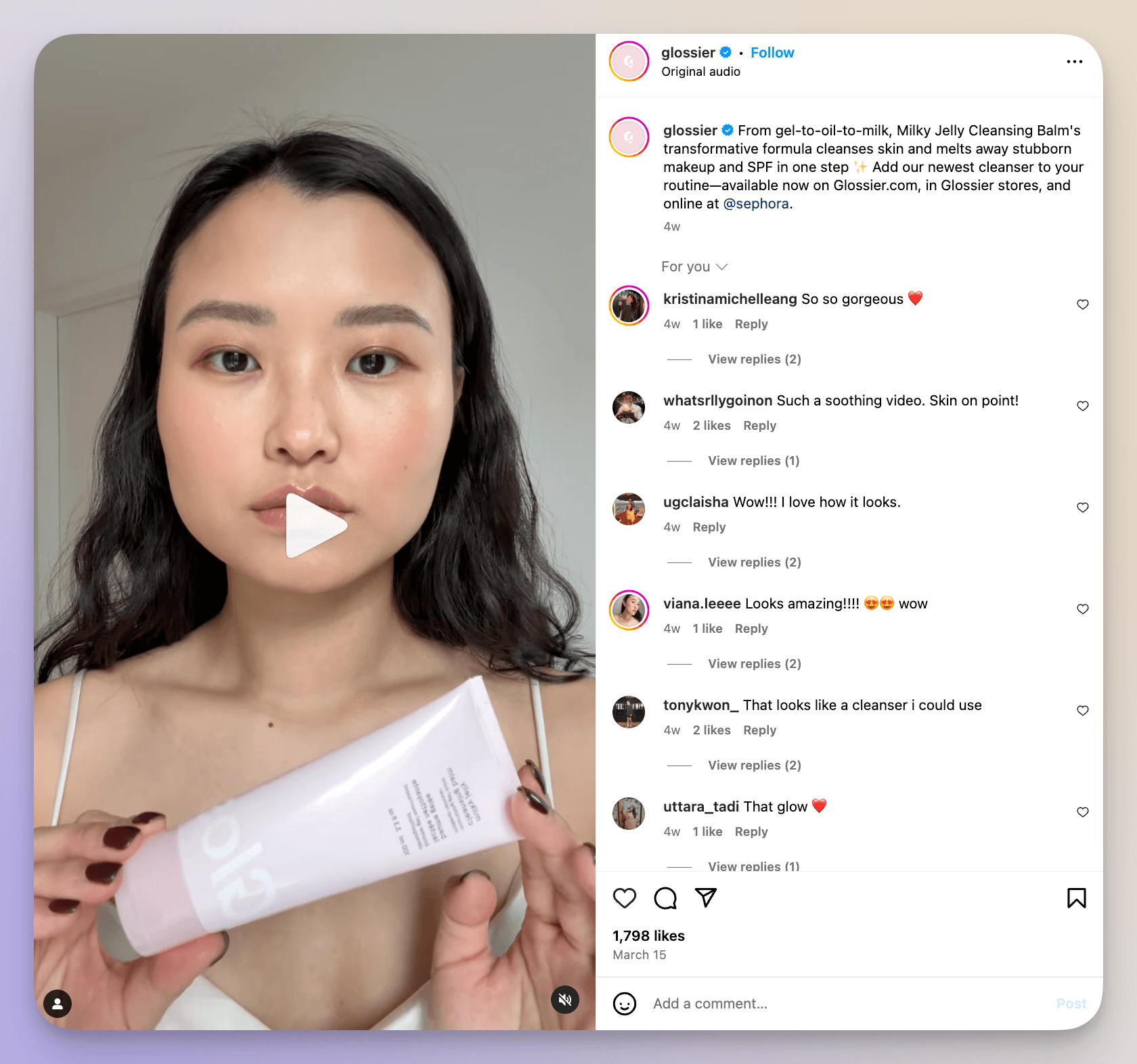
On TikTok, CeraVe often partners up with micro-, macro- and even celebrity influencers in the skincare industry to create “medutainment” content for their audience.
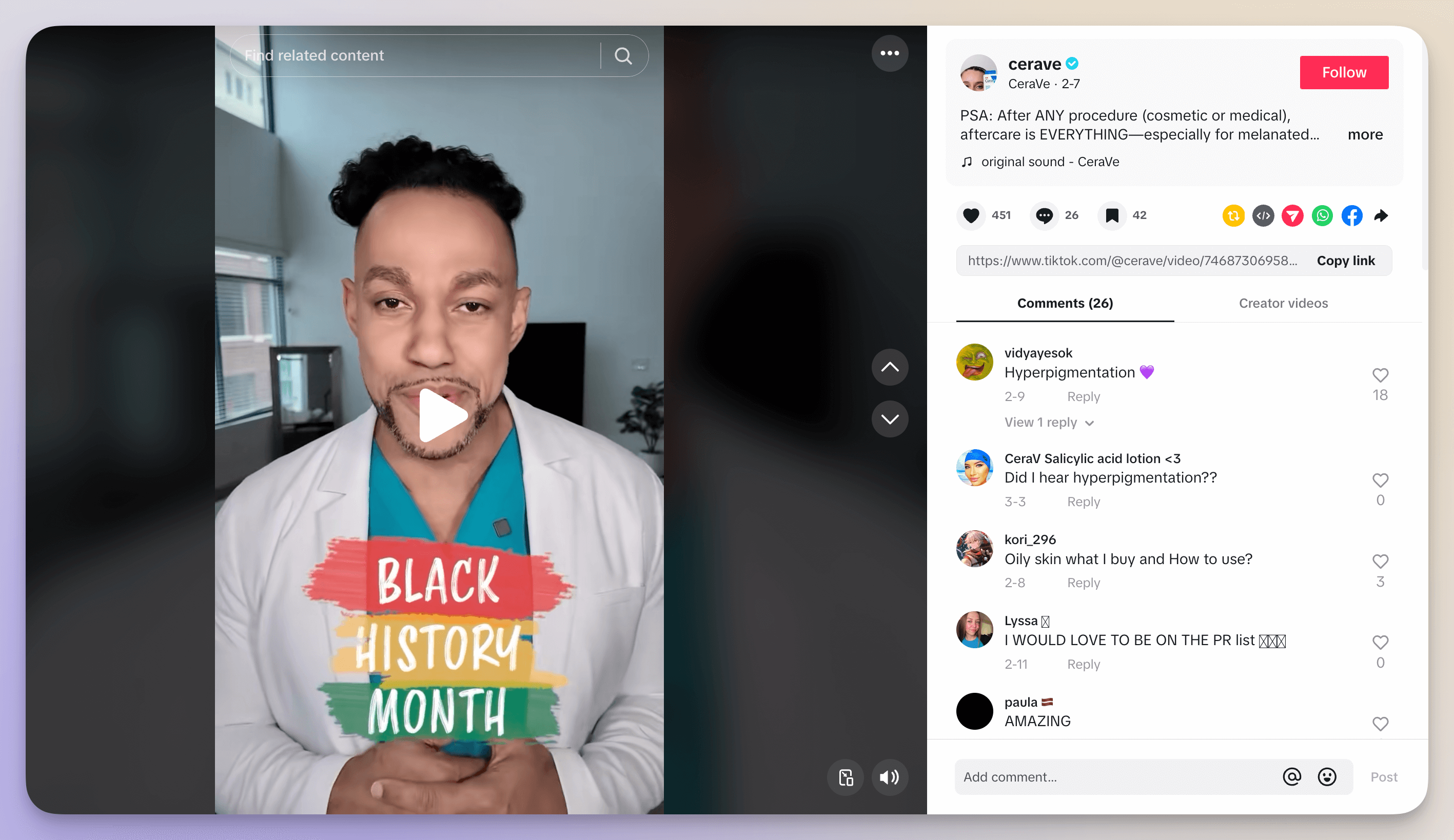
Pro tip: If you’ve started a collaboration with an influencer on TikTok or Instagram, and you want to take a look at their past campaigns data, or track your current influencer marketing efforts, Socialinsider can help you get a quick peek (or a deep dive, depending on your needs) into all the relevant Instagram or TikTok analytics.
All you need to do is add the brand profile into the app, navigate to the Posts tab and filter your search by a campaign (or influencer) specific keyword. I filtered my search using the “dermdoctor” keyword – the TikTok handle of a famous influencer often featured in CeraVe content.
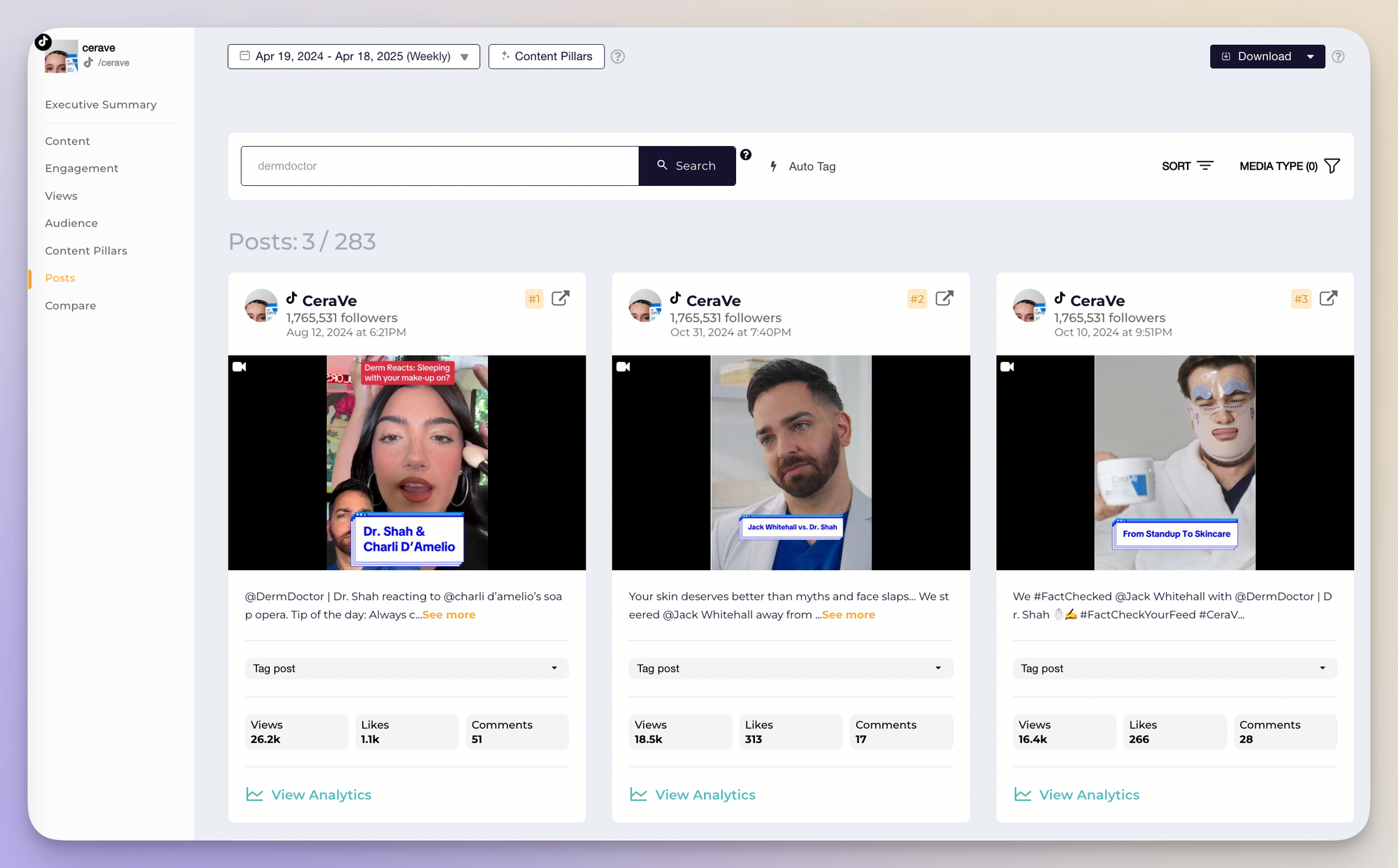
Paid advertising
Instagram ads tend to be more effective during the consideration and conversion stages, due to the platform’s highly precise targeting capabilities and mature ad tools.
TikTok advertising lets brands tap into viral reach at lower costs, which greatly impacts small businesses that want to gain exposure fast without making a dent in their budget. But at the end of the day, paid TikTok vs Instagram marketing comes down to strategy.
TikTok’s ad platform use an auction-based model, with four primary bidding strategies:
- CPM (Cost per thousand impressions) - for reach.
- CPM (Optimized cost per thousand impressions) – for interactions, followers, lead generation, shop purchases.
- CPV (Cost per View) - for video views.
- CPC (Cost per Click) - for traffic, product sales, conversions.
Creative requirements and performance metrics by platform:
For Instagram:
- Ideal ad video length: 5-15 sec for Stories, up to 60 sec for Reels/in-feed video.
- Metrics to track: likes, comments, shares, saves.
- Preferred content style: Polished visuals with CTA or video.
- Audio: Trending songs boost engagement.
- CTA: Text-based CTA, swipe-ups, shopping tags.
For TikTok:
- Ideal ad video length: 15 sec maximum.
- Metrics to track: watch time, shares, replays, comments.
- Preferred content style: trend-based, casual/authentic ads.
- Audio: trending audio is a must-have for maximum visibility.
- CTA: in captions or on video.
Case study: Airbnb on Instagram vs Chipotle on TikTok
When it comes to paid advertising on Instagram, Airbnb relies heavily on targeted ads (based on the audience’ location and search history). They’re also rolling more generic brand awareness ads for specific use cases – usually in video format.
Chipotle, on the other hand, takes a strategic approach to paid advertising on TikTok, choosing quality over quantity.
One of their biggest wins was the "TikTok Timeout" Super Bowl campaign in 2020, which was designed to go head-to-head with traditional TV ads.
Beyond paid promotions, Chipotle keeps the momentum going with viral challenges that bring them massive brand exposure and sales.
Social selling
With its solid shopping infrastructure and powerful product discovery system, Instagram seems to be a clear leader when it comes to social selling.
But can there be a world where TikTok is better than Instagram at social commerce? Well, one thing’s for sure, TikTok’s catching up fast by making shopping feel fun and spontaneous, and by capitalizing on impulse purchases.
Instagram Shopping
- Product tags: can be placed in posts, Stories, Reels and ads.
- Product discovery: easy, through the Explore tab, dedicated shop section, and targeted ads.
- Remarketing: precise remarketing through Meta Ads, plus abandoned cart reminders and brand DMs.
- Checkout experience: in-app checkout available in some regions, otherwise users get redirected to the seller’s website (which can add some friction to the path-to-purchase).
- Conversion: higher for planned/well-thought purchases and luxury/artisanal/unique products.
- Suited for: trusted brand purchases.
TikTok Shopping
- Product tags: most commonly be found in videos and livestreams.
- Remarketing: based largely on user interactions, livestream notifications.
- Product discovery: easy because the algorithm encourages exposure to new products.
- Checkout experience: in-app checkout (no friction).
- Conversion: higher impulse buys and live shopping.
- Suited for: viral products and real-time shopping.
Case study: Mejuri on Instagram vs Drunk Elephant on TikTok
As a luxury jewelry brand on Instagram, Mejuri has created an aura of exclusivity around their products.
The brand relies heavily on influencer collabs and shoppable content – which encourage and allow their users to browse and buy their products with just one tap. Their storefront is aesthetic and well-organized, primed for purchase.
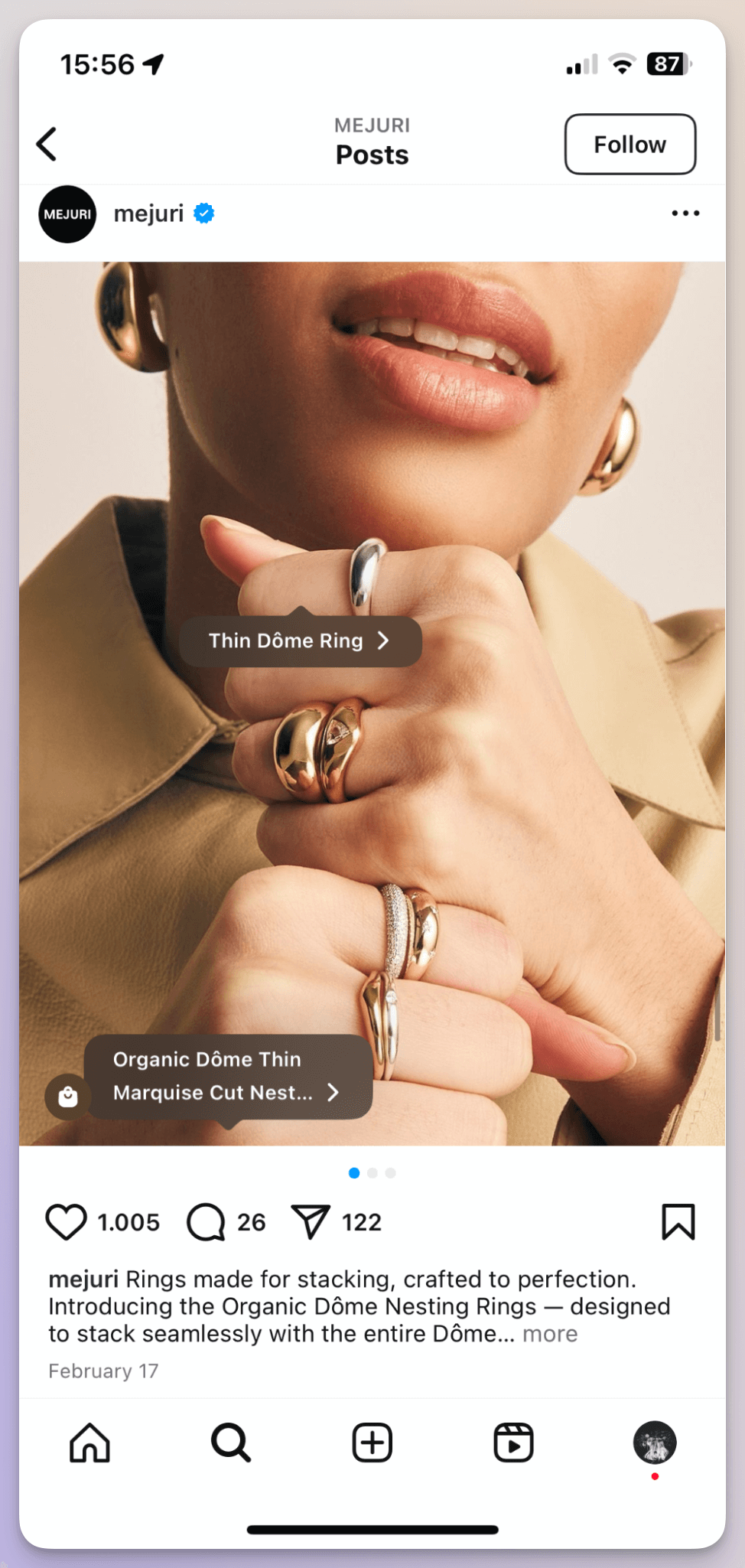
Drunk Elephant, a skincare brand with a solid presence on TikTok, has a unique approach to social selling.
Instead of simply showcasing their skincare product, they turn it into a fun, interactive experience. They regularly host live shopping events and make it super easy to shop by linking straight to their TikTok Shop.
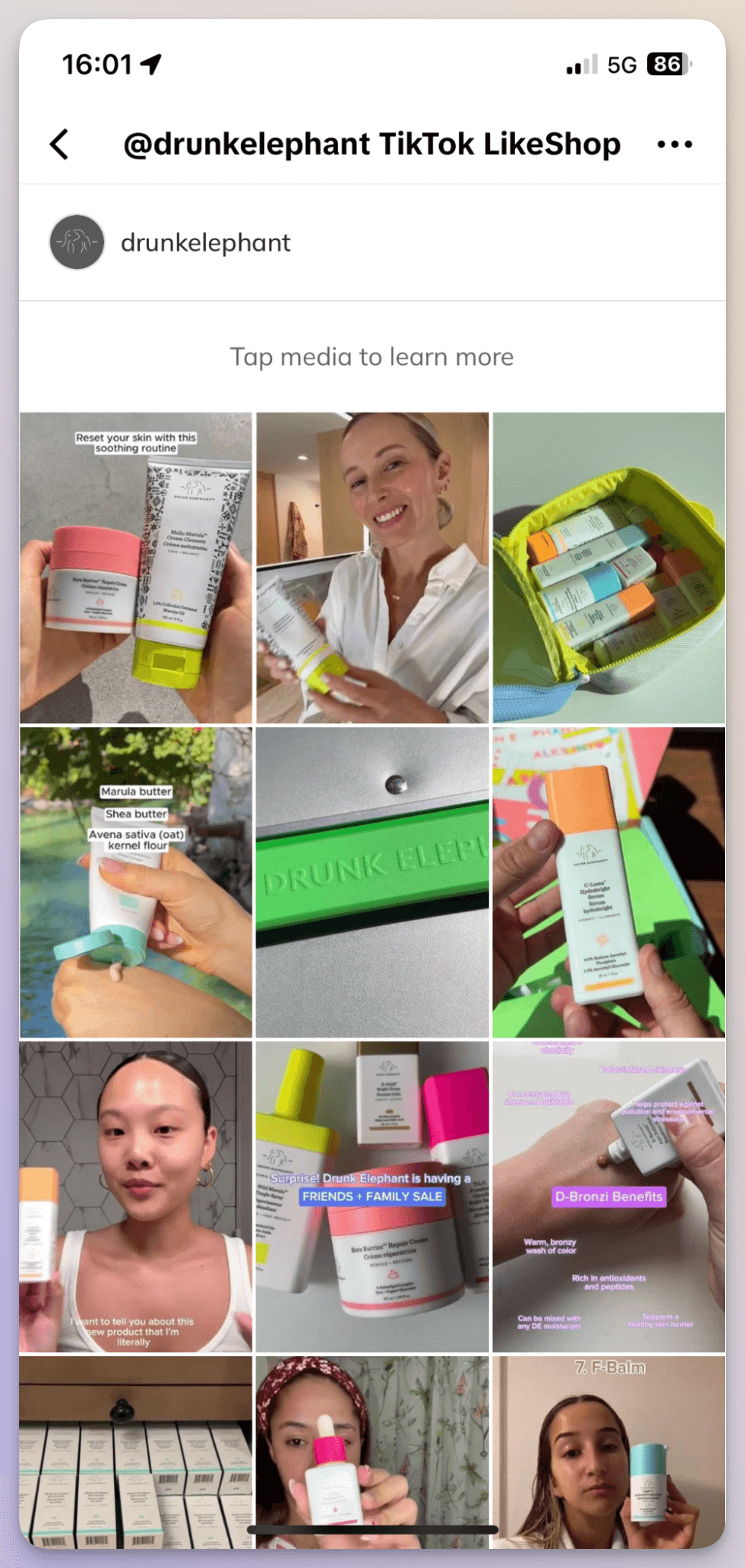
User-generated content campaigns (UGC)
UGC is thriving on both TikTok and Instagram, but if we’re talking about the difference between Instagram and TikTok, TikTok definitely takes the lead with its viral challenges and remix-friendly culture.
Instagram also embraces UGC, but its users often need a little push – either through contests, shoutouts, or brand incentives – to join in and start creating content.
- Best fit: structured UGC campaigns
- Branded hashtags: used to track submissions and boost organic reach
- Reposting: brands usually repost top submissions for extra exposure and engagement
TikTok
- Best fit: viral UGC campaigns and challenges
- Trending sounds: key for boosting visibility
- Organic participation: anyone can easily join in trends started by influencers or brands
Case study: Aerie on Instagram vs Ocean Spray on TikTok
Aerie has built a reputation on Instagram for being an effortlessly cool, feel-good clothing brand. It thrives on authenticity and body positivity, and that extends to their UGC campaigns (or movements) on Instagram.
The #AerieREAL campaign is a prime social media marketing example of that. Through the branded hashtag, Aerie encourages its community to share unfiltered moments which not only builds brand awareness but also boosts meaningful engagement.
In the case of Ocean Spray, TikTok is good for tapping into viral UGC campaigns and challenges to expand their reach.
One of their breakout moments happened back in 2020 when Nathan Apodaca skateboarded his way into internet virality, sipping their Cran-Raspberry juice to the tune of Fleetwood Mac’s “Dreams.”.
Recognizing the potential of this UGC, Ocean Spray amplified it by turning into a campaign with the hashtag #DreamsChallenge.
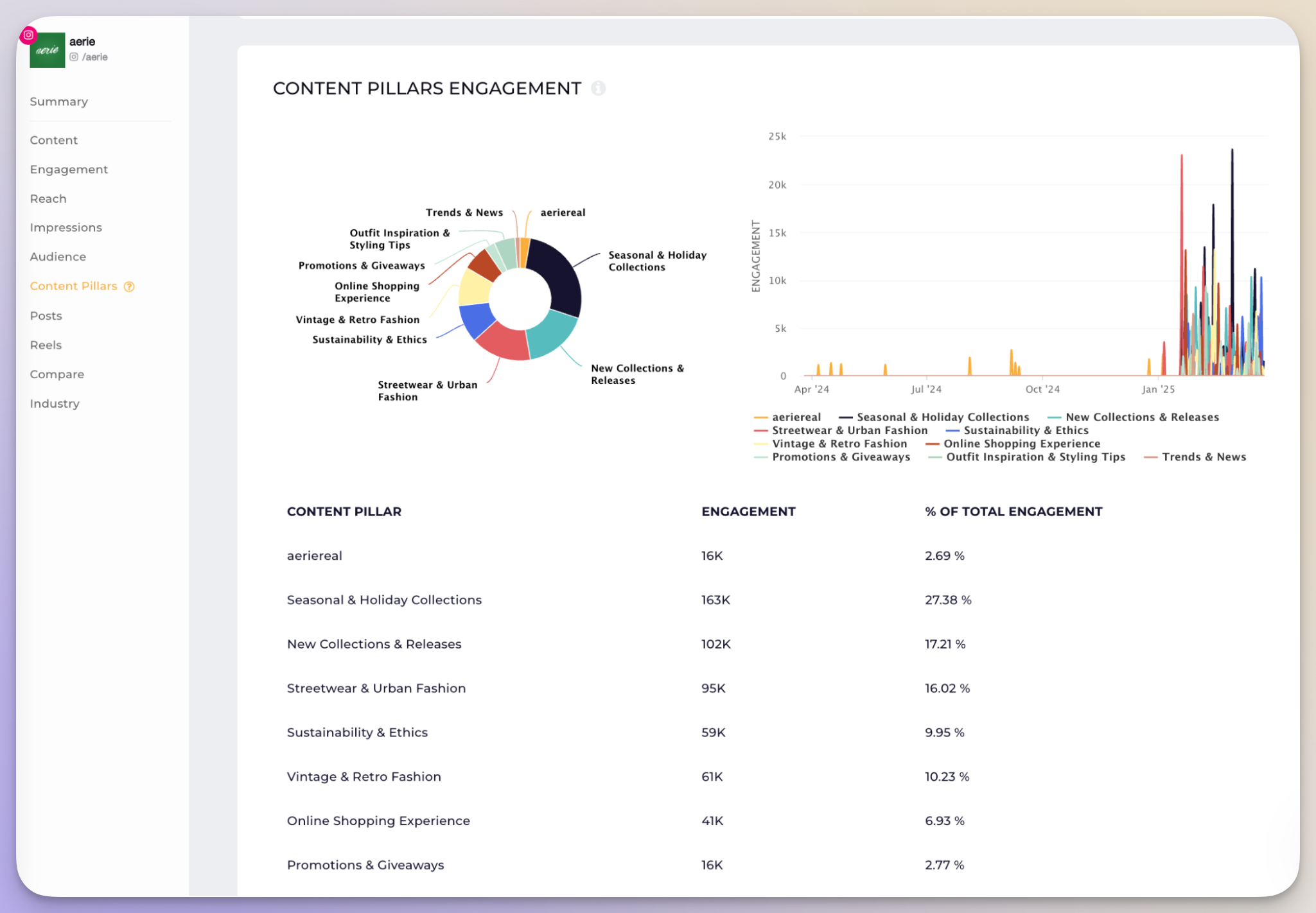
Affiliate and sponsorship structures
Instagram’s powerful tracking tools and rich affiliate network give creators and brands a solid framework for affiliate marketing.
TikTok is slowly catching up but still lacking a strong attribution system. Why TikTok is better than Instagram for some, though, is its more organic approach, which allows for more creative freedom.
- Integration and tracking: affiliate links can be easily shared in Stories (a great option for Instagram Story ideas that drive sales); affiliate traffic can be tracked using UTM parameters and Meta Pixel.
- Branded content: sponsorships can be easily marked as such, which allows brands to monitor engagement on those posts.
- Product tags: creators can simply tag products in their posts and get commissions based on sales.
TikTok
- Product tags: similarly to Instagram, TikTok creators can earn commissions by tagging products in their posts.
- Link in bio: clickable links are limited outside of ads, so many creators choose to add affiliate links in their bios.
- Promo codes: for the same reasons, many creators share discount codes and measure conversions based on their usage.
Case study: LTK on Instagram vs SoFi on TikTok
For any influencers looking to monetize their content, LTK is a real treasure trove. Through their Instagram platforms, creators can share shoppable posts with products tagged directly, and earn commissions based on the sales these products generate – a straightforward and profitable affiliate strategy.
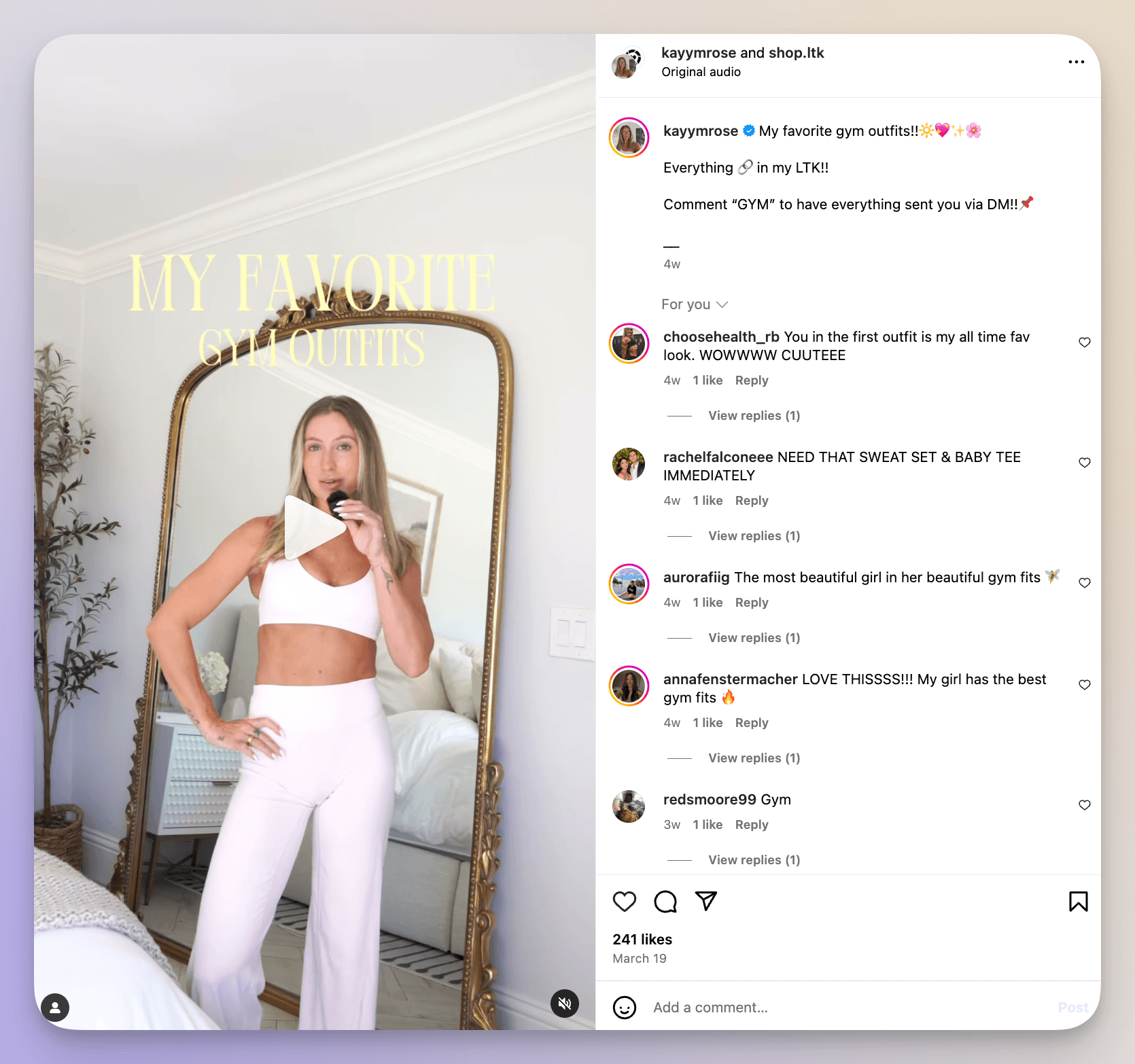
On TikTok, SoFi uses sponsorships to collaborate with influencers in the finance industry, and create engaging TikTok-style content that breaks down complex financial topics.
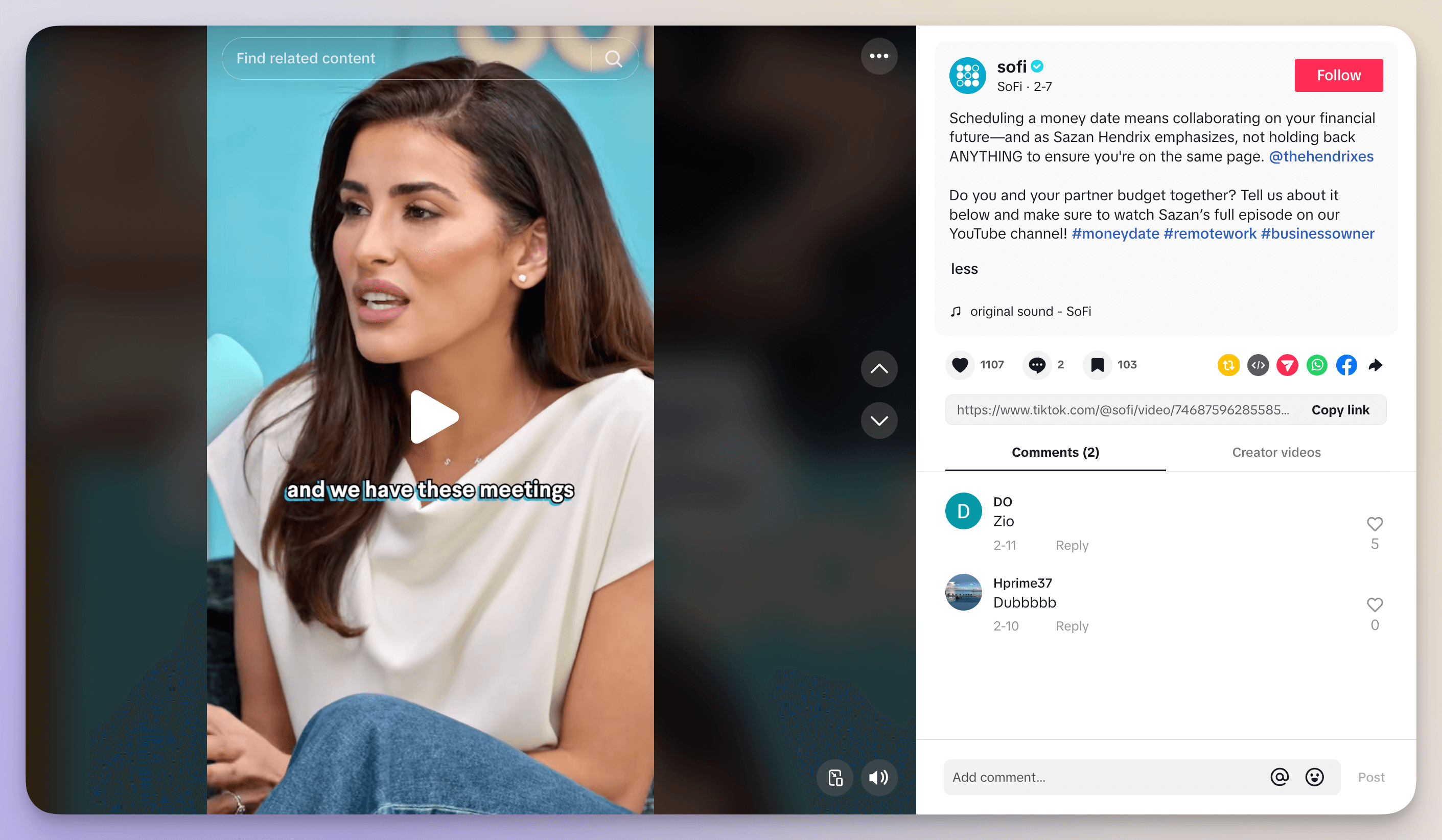
Community building
Community building is a big priority on both TikTok and Instagram, however each platform approaches it differently.
Instagram's strengths and weaknesses come into play here – on Instagram, communities tend to be more stable and loyal, but grow slowly over time. TikTok’s highly-interactive culture encourages community growth and visibility, but that doesn’t always translate to long-term loyalty.
Still, those looking for faster growth will usually favor TikTok over Instagram.
- Brand identity: on Instagram, brands aim to build a recognizable presence.
- DMs and Close Friends lists: brand-audience connections can be deepened through personalized interaction.
- Funnel stage strengths: Instagram shines in the audience retention stage, but also supports awareness, engagement and conversion.
TikTok
- Trend hijacking: brands that join trends or challenges get a massive reach of visibility and the chance to expand their community overnight.
- Duets/Stitches: these interactive features encourage co-creation and contribute to community-building.
- Funnel stage strengths: TikTok is a great driver of brand awareness, but also has great potential for engagement.
Final thoughts
Choosing between Instagram and TikTok comes down to understanding what each platform does best. Instagram leans into polished visuals and diverse content formats, while TikTok thrives on raw creativity and viral trends.
By examining user demographics and performance metrics like engagement, impressions, and shares, brands can better gauge where their content will resonate.
Add in each platform’s unique toolsets—from Instagram’s shopping and Stories features to TikTok’s algorithm-driven discovery and editing tools—and it becomes clear that success lies in aligning your strategy with the strengths of the platform—and your audience.
Analyze your competitors in seconds
Track & analyze your competitors and get top social media metrics and more!
You might also like
Improve your social media strategy with Socialinsider!
Use in-depth data to measure your social accounts’ performance, analyze competitors, and gain insights to improve your strategy.



